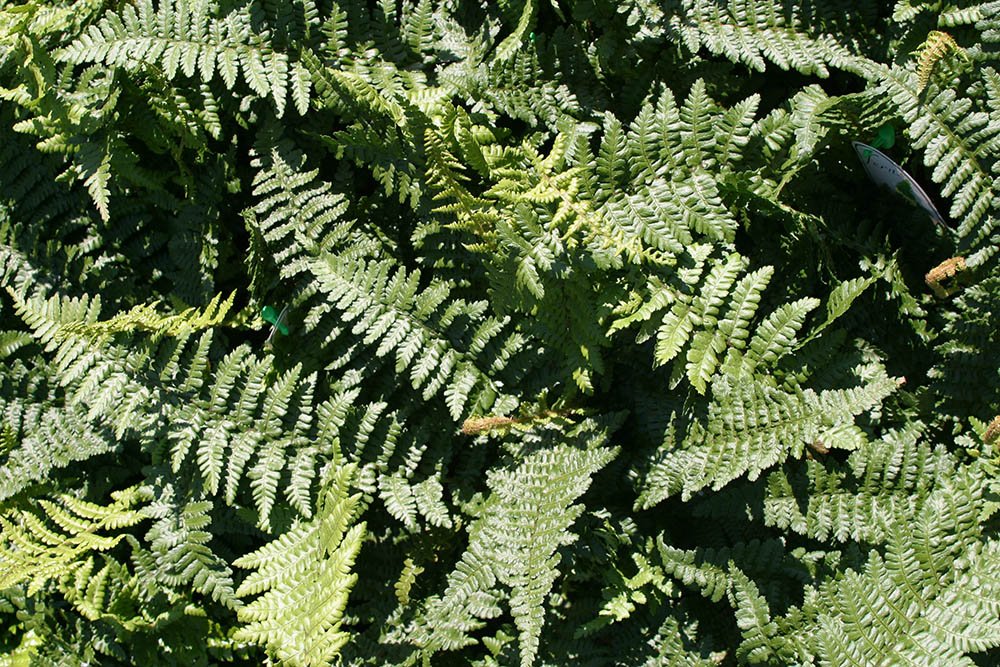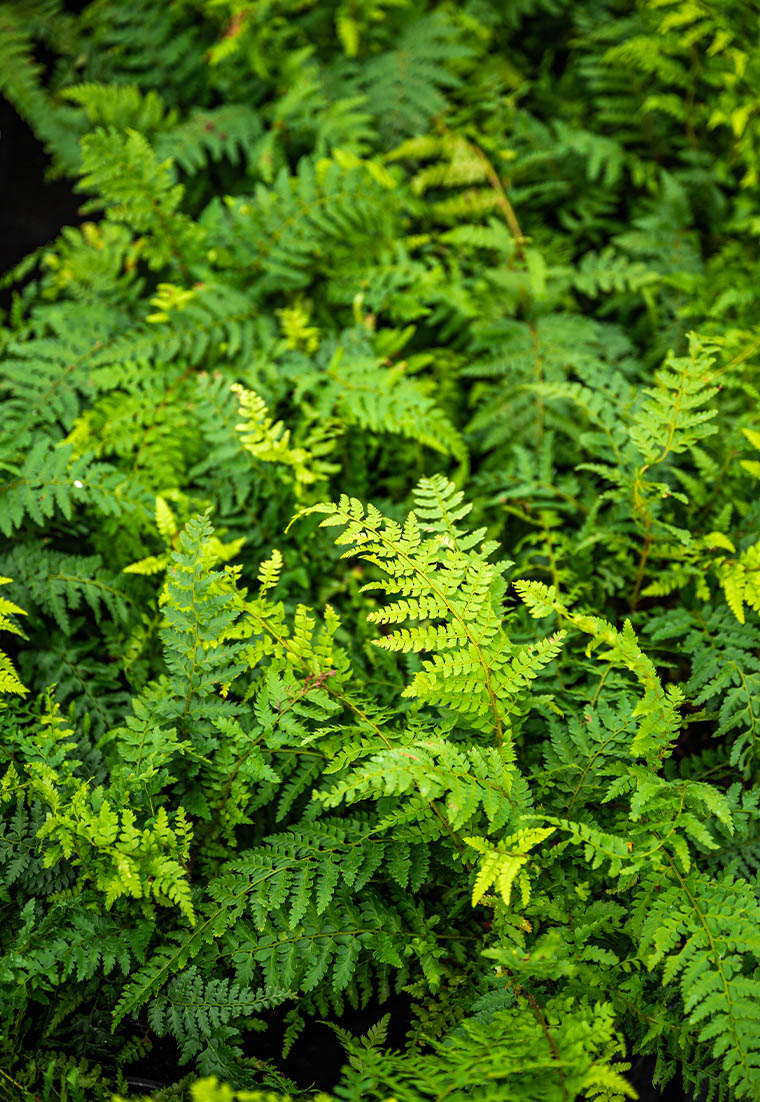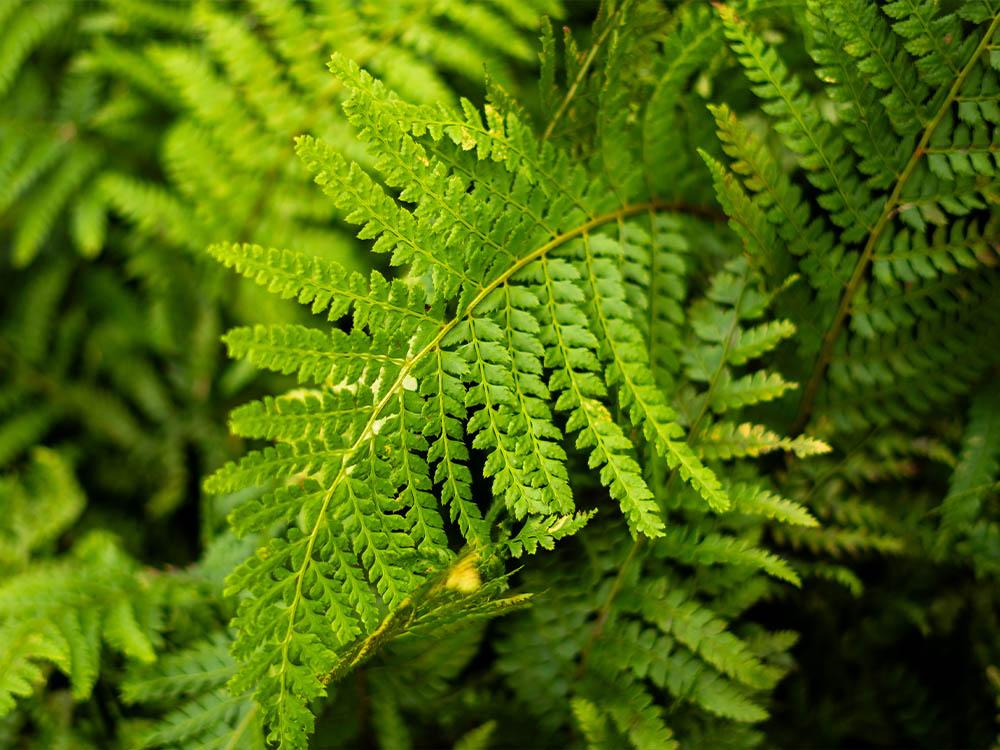Focus on ferns
Bringing structure and texture to landscapes
Ferns are often found in woodlands and forests, and bring interesting texture to landscapes. Their intricate fronds and rich green tones make them perfect for adding both structure and softness, elevating the visual interest of planting schemes.
Ferns are defined as vascular plants. These are plants that reproduce via tiny spores, do not produce seeds or flowers, and have true stems, roots, and leaves. They belong to a larger group, known as Pteridophytes, and this group is made up of all spore-producing vascular plants. Within this group, ferns are normally placed within the division known as Polypodiopsida, or commonly known as the true ferns. This means that rather than being a family of plants, such as Rosaceae, or Lamiacaea, they are a class of their own.
Key Characteristics:
✓ Evergreen or deciduous
✓ Textured fronds
✓ Foliage colours range from green, bronze, red, to silver
✓ Height varies from 0.4-1.5m
✓ Most thrive in full or partial shade, but some do well in full sun
✓ Low-maintenance
✓ Ideal for underplanting trees, or in shady borders
✓ Can provide groundcover, or architectural interest
✓ Perfect for woodland or naturalistic planting schemes
Hardy ferns are incredibly diverse, ranging from evergreen varieties that provide year-round colour and structure, to deciduous species with new growth, known as croziers, that unfurl in spring to reveal striking new fronds and bristled stems. Some bring architectural interest, such as Matteuccia struthiopteris and Dryopteris wallichiana, whilst others are more suited to providing mats of groundcover, including Polypodium vulgare. Ferns are available in a range of colours, including various shades of green, bronze, red, and silver. There are over 15,000 known species, and they can be found on every continent.
Some species thrive in damp, shady spots, whilst others are well-suited to dry soils and typically found beneath trees. Ferns are renowned for their wide variety of foliage shapes and textures, including feathery, soft fronds to glossy, leathery leaves. Occasionally, ferns have distinctive black or brown scale detailing on their fronds. Many feature a shuttlecock shape, with new growth unfurling from the centre in spring. Others offer seasonal interest, such as Dryopteris filix–mas that transitions to copper in autumn. Ferns tend to reach a height of between 0.4m-1.5m, depending on the species.
Did you know?
Ferns are ancient in evolutionary terms, and first appeared around 360 million years ago. They are older than flowering plants, so unlike many garden favourites, they don’t produce flowers.
Ferns look fantastic when combined with many plants, but in particular, species including Hosta, Heuchera, Tiarella, and Helleborus create a showstopping planting combination. They are generally low-maintenance and easy to grow, and the majority of species prefer dappled or full shade, making them a natural choice for woodland and naturalistic gardens, as well as shaded borders. However, some ferns prefer full sun, such as Polypodium vulgare. It’s important to select the appropriate fern species for the desired planting area.
Ferns provide valuable benefits to biodiversity, and their presence contributes to a healthier and more balanced ecosystem. Their dense, arching fronds create shelter and nesting spots for small insects and invertebrates, such as spiders, butterflies, and caterpillars. They also provide a food source for caterpillars and other herbivores. Our largest land mammal, the red deer, also grazes on hard fern fronds, especially in winter, when other plant life is sparse. By naturally increasing humidity and providing shade, they help maintain moisture levels in the soil, which creates a more favourable microclimate for other shade-loving plants, mosses, and fungi to thrive.

Asplenium scolopendrium
Our recommended fern species

Asplenium scolopendrium
Asplenium scolopendrium
An evergreen UK native fern that forms neat rosettes of wavy edged, strap-shaped fronds. Great for heavily shaded areas and looks fantastic amongst shade loving shrubs as part of a mixed border. Grows to around 40cm in height.
Athyrium filix-femina
A deciduous, vigorous UK native fern with delicate, bright green, lacy fronds that form a shuttlecock shape. One of the taller hardy fern species, reaching around 1.2m. Ideal for moist but well-drained, shady borders and woodland gardens.
Athyrium niponicum
A striking deciduous fern that reaches a height of around 40cm, with silvery-grey fronds tinged with burgundy and green. Commonly known as the Japanese painted fern, Athyrium niponicum brings unique colour and texture to shaded borders and containers. Can also be grown to provide groundcover. Prefers moist but well-drained soil and sheltered, shady spots.
Blechnum spicant
An evergreen native fern with a neat, clump-forming habit, and narrow, glossy, dark green sterile fronds, with tall, erect fertile fronds that appear in the growing season. Grows to around 50cm in height and prefers full to partial shade, in moist, well-drained soil. Perfect for adding year-round structure to woodland gardens.
Dryopteris affinis
A semi-evergreen native fern that forms a rosette of upright, golden-green fronds that emerge in spring, which later transition to rich green, with golden scales on the stems. Reaching a height of around 1.2m, Dryopteris affinis is ideal for adding architectural interest. Prefers moist but well-drained soil, and can cope with all light levels.

Athyrium filix-femina

Dryopteris affinis
Dryopteris filix-mas
A large, deciduous native male fern with green, feathery, lance-shaped fronds forming a shuttlecock shape, which transform to a coppery shade in autumn. Grows to around 1.2m in height. Great for naturalistic planting and prefers full or partial shade.
Dryopteris wallichiana
A semi-evergreen fern with tufts of shuttlecock-like, arching fronds which are yellow-green when young and mature to a rich green. Commonly known as alpine wood fern, Dryopteris wallichiana thrives in full or partial shade, in moist, well-drained soil. Reaches a height of around 90cm.
Matteuccia struthiopteris
A deciduous fern of erect rosettes with lacy, pale green sterile fronds, alongside shorter, brown fertile fronds. A fantastic foliage plant for woodland gardens. Reaches around 1.5m in height, and thrives in sheltered spots, in full or partial shade.
Polipodium vulgare
A native evergreen fern that has leathery, lance-shaped, dark green fronds with pimply undersides. One of the smaller species, Polipodium vulgare grows to around 30cm in height. Works well in gravel gardens or underplanting deciduous trees, as well as providing groundcover. Ideal for growing in dry shade.
Polystichum setiferum
A large, native, evergreen, tufted fern with dark green, softly arching fronds and orange-brown stalks. The fronds emerge upright in habit until they unfurl and open. Grows to around 1.2m in height, and thrives in full or partial shade, in moist, well-drained soil.

Dryopteris filix-mas

Matteuccia struthiopteris

Polystichum setiferum
How to grow and care for ferns
Ferns are generally low-maintenance and easy to grow. They’re best planted in spring or autumn, giving them time to settle in before any extremes of hot or cold weather. Most ferns are woodland plants and grow best in light or dappled shade, although some species can tolerate sun if the soil stays consistently moist.
Ferns thrive in soil that is rich in organic matter, particularly if they’re underplanting trees where competition for nutrients and water can be higher. Adding organic matter before planting will help to improve the soil and give ferns a strong start. Some species, including Asplenium scolopendrium, prefer neutral to slightly alkaline soil, whilst Matteuccia struthiopteris prefers acidic to neutral. It’s best to fully research soil requirements when selecting ferns to include in your planting plan.
It’s important to water new plants regularly during their first year, until fully established. Once settled in, most ferns require little watering, except for during particularly dry spells. Feeding requirements are minimal, but a mulch of organic matter in spring will help to maintain soil moisture and suppress weeds. Pruning can be carried out in late winter or early spring by removing any damaged or tired fronds, whilst taking care not to damage any new fronds.
Pests and diseases that affect ferns
Ferns are generally quite resilient and rarely suffer from major pest problems. However, there are a few issues that can occasionally affect their health, especially in damp or sheltered environments.
Slugs and snails
These are the most common pests that can damage young fronds, particularly in spring, when ferns are actively growing. These pests can be controlled by clearing away any fallen leaves or debris around the plants, and by encouraging predators, such as birds, hedgehogs, and frogs, into your green space to keep slug and snail populations under control.
Aphids
These pests can sometimes appear on the undersides of fern fronds, feeding on the sap. Whilst not usually fatal, they can cause distortion of new growth. Aphids can usually be controlled and eliminated by natural predators, however, if this is not successful, then biological products can be used to treat them.
Rust
Ferns can be susceptible to rust — a fungal disease that causes orange or brown spots to appear on fronds. Rust can be managed by removing infected fronds and improving air circulation around the plants. Avoid overhead watering, as this can encourage fungal growth.
Root rot
Ferns can occasionally suffer from root rot if grown in poorly-drained soils. This is more likely to occur if the fern is planted too deeply or in areas where the soil remains waterlogged for prolonged periods. To prevent root rot, ensure the soil has good drainage and avoid overwatering, particularly during winter in their dormant months.
With their interesting foliage textures and shapes, and low–maintenance nature, ferns are an excellent addition to elevate landscapes. Find out more about fern species we grow and sell by contacting the G Team today.

